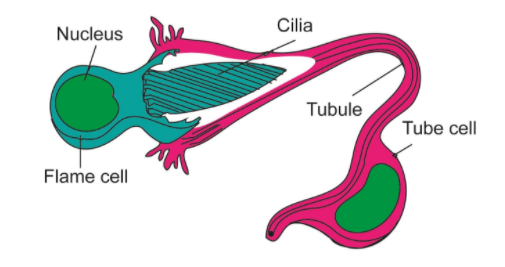
Flame cells are associated with -
(a)Respiration
(b)Excretion
(c)Nutrition
(d)Digestion
Answer
474k+ views
Hint: The flame cells are to a flatworm are what a nephron is to a human being. They are associated with the elimination of waste from the body. They are named so because one of the parts of the cell looks like a candle flame.
Complete answer:
- Flame cells are found in freshwater invertebrates like flatworms (Platyhelminthes), rotifers (Rotifera), and ribbon worms (Nemertea).
- They function as kidneys of the organism. Bundles of flame cells are known as protonephridia.
- The cell contains a nucleated cell body with a cup-shaped projection. The inner surface of the projection is covered by flagella.
- The cup is attached to a tube cell, whose inner surface is coated in cilia, which aid in liquid movement through the tube cell. This tube opens into a nephropore or an excretory bladder.
- Tube cells also contain microvilli that may help in the reabsorption of some ions.
Additional Information: - Platyhelminthes are flattened, soft-bodied, and invertebrate organisms and are either free-living or parasitic. Most of them possess a blind gut, i.e. they have a mouth but no anus.
- Flame cells also maintain the organism’s osmotic and ionic balance.
- The name is derived from the beating of the flagella, which resembles a flame.
- During excretion, molecules enter the tube cells through the gap between the flame cell and tube cell.

So, the correct answer is ‘excretion’.
Note: - Other examples of units responsible for excretion include nephrons in humans, nephridia in annelids, malpighian tubules in arthropods, and solenocytes in cephalochordates.
- Flame cells extract water and waste materials from the mesenchyme, the connective tissue in these organisms.
- Bundles of flame cells are known as protonephridia.
Complete answer:
- Flame cells are found in freshwater invertebrates like flatworms (Platyhelminthes), rotifers (Rotifera), and ribbon worms (Nemertea).
- They function as kidneys of the organism. Bundles of flame cells are known as protonephridia.
- The cell contains a nucleated cell body with a cup-shaped projection. The inner surface of the projection is covered by flagella.
- The cup is attached to a tube cell, whose inner surface is coated in cilia, which aid in liquid movement through the tube cell. This tube opens into a nephropore or an excretory bladder.
- Tube cells also contain microvilli that may help in the reabsorption of some ions.
Additional Information: - Platyhelminthes are flattened, soft-bodied, and invertebrate organisms and are either free-living or parasitic. Most of them possess a blind gut, i.e. they have a mouth but no anus.
- Flame cells also maintain the organism’s osmotic and ionic balance.
- The name is derived from the beating of the flagella, which resembles a flame.
- During excretion, molecules enter the tube cells through the gap between the flame cell and tube cell.

So, the correct answer is ‘excretion’.
Note: - Other examples of units responsible for excretion include nephrons in humans, nephridia in annelids, malpighian tubules in arthropods, and solenocytes in cephalochordates.
- Flame cells extract water and waste materials from the mesenchyme, the connective tissue in these organisms.
- Bundles of flame cells are known as protonephridia.
Recently Updated Pages
Master Class 11 Economics: Engaging Questions & Answers for Success

Master Class 11 Business Studies: Engaging Questions & Answers for Success

Master Class 11 Accountancy: Engaging Questions & Answers for Success

The correct geometry and hybridization for XeF4 are class 11 chemistry CBSE

Water softening by Clarks process uses ACalcium bicarbonate class 11 chemistry CBSE

With reference to graphite and diamond which of the class 11 chemistry CBSE

Trending doubts
What are the elders in Goa nostalgic about class 11 social science CBSE

Formaldehyde at room temperature is ALiquid BGas CSolid class 11 chemistry CBSE

Define least count of vernier callipers How do you class 11 physics CBSE

Distinguish between Mitosis and Meiosis class 11 biology CBSE

Why are forests affected by wars class 11 social science CBSE

Explain zero factorial class 11 maths CBSE




